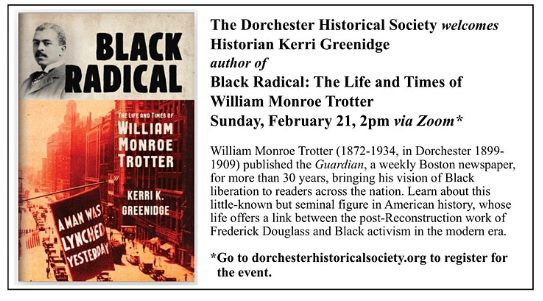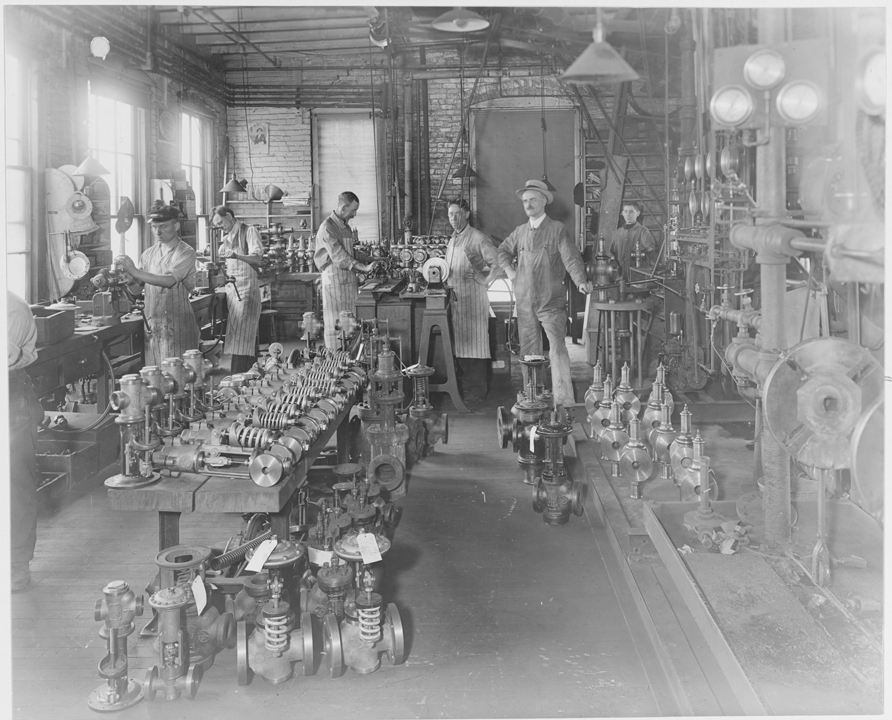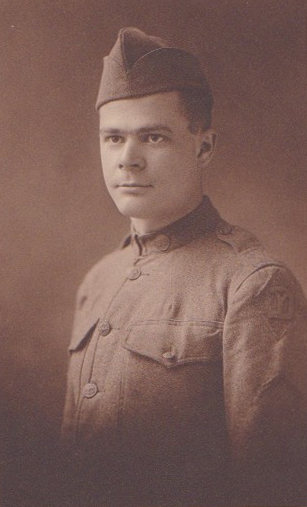Antonio Iazzetti and Alberto Iazzetti
World War I Veteran
By Camille Arbogast
Antonio Iazzetti, known as Anthony Iazetti, was born on July 12, 1896, in Torremaggiore, Foggia, Apulia, Italy. His younger brother, Alberto, or Albert, was also born in Italy on May 1, 1900. Their parents were Giovanni (known as John) and Maria (DeLila) Iazzetti. John was a baker. According to the 1910 census, the couple were parents to 15 children, seven of whom were still living at that time.Anthony and Albert’s siblings included: Theresa (known as Susie) born 1893, Celestina (known as Anna) born in 1895, Italia (known as Emma) born c1898, Clara (known as Ida or Ada) born in 1908, and Arturo (known as Arthur) born in 1916.
The Iazzettis immigrated to the United States in the first decade of the 20th century, travelling on the Lloyd Sabaudo line’s SS Re d’Italia. According to Anthony’s immigration records, he entered the United States in 1908, while Albert stated that he arrived in 1909. They both reported that they left from Naples, Italy, and arrived in New York in late November, Anthony specifying he arrived on Thanksgiving. Their sister Clara was born in Boston in August 1908. At that time, the Iazzettis were living at 19 Pitts Street, near Bowdoin Square in Boston’s West End. By 1916, they had moved to 981 Dorchester Avenue. That March, Albert went missing. After two days, in which his mother “searched the neighborhood in which she lives, called on relatives and friends where she thought the boy might have been, [and] watched the crowds going to and from the moving picture houses,” she decided to involve the police in the search. The Boston Globe reported that “the lad was more than ordinarily bright and stood high in his class, according to his mother.” There was no coverage of Albert’s return, though he appears to have come home eventually. By 1918, the Iazzettis had moved to 1745 Dorchester Avenue, which would be occupied by members of the family for at least the next 50 years.
On June 4, 1918, Anthony enrolled in the U.S. Naval Reserve Force. The next day he registered for the First World War draft. On his draft registration, he reported that he was already working for the military, employed by Captain Wheeler of Camp Devens in Ayer, Massachusetts. He may have worked as a barber at Camp Devens; on July 12, 1918, Anthony filed a petition for citizenship, stating his profession as barber. Anthony was called to duty in the Navy on July 5, 1918. He served as a Ship’s Cook, 4th class. He was initially stationed at the Naval Training Camp in Hingham, Massachusetts. On July 25, he was transferred to the Navy Rifle Range in Wakefield, Massachusetts. Anthony became an American citizen on September 5, 1918. His final Naval assignment was at the Receiving Ship in Boston, where he was stationed from September 30 until November 11, 1918. He was placed on inactive duty on July 22, 1919, and given an honorable discharge at the expiration of his enrollment on June 2, 1922.
Albert declared his intention to become an American citizen on July 24, 1918, the same day he enrolled in the Navy at the Recruiting Station in Boston. On his citizenship papers he stated that his occupation was rivet heater. He was sent to the Naval Operating Base in Norfolk, Virginia, on August 28, 1918. There he initially served as a mess attendant, third class. After 69 days, he was made a seaman 2nd class. On November 5, he was transferred to the USS Tenadores where he remained until November 11, 1918. Albert was placed on inactive duty on October 13, 1919, and honorably discharged on July 23, 1922.
After the war, Albert returned to Dorchester. In 1923, he was living at 16 Virginia Street and
working as a laborer. The next year, on February 13, he married Lillian J. Doyle in New York City. He appeared in the Boston directory in 1926 and 1927, at the family home at 1745 Dorchester Avenue. Albert and Lillian were listed in the Boston directory in the mid-1930s living at 957 Massachusetts Avenue in Roxbury; Albert was listed as an ironworker. From 1938 through 1942, Albert appeared in the directory back at 1745 Dorchester Avenue. On his World War II draft registration, filled out in February 1942, Albert reported that he lived at 215 Manhattan Avenue, Apartment 58, in the Bronx, New York City, and worked for the New York Rapid Transit Company, 159th– 8th Avenue IRT System.
On March 23, 1942, Albert enlisted in Company C, 8th Regiment, New York Guard, remaining with the unit until May 25, 1943. On November 9, 1943,he enlisted in the Navy in Boston. He was called to duty on June 19, 1944. After some time at the receiving station in Mobile, Alabama, he was transferred to the newly commissioned USS Zaniah (AG-70), a “special stores-barracks-distilling ship,” with “a distilling plant capable of producing 80,000 gallons of fresh water.” The ship had been converted to a Navy vessel at the Alabama Drydock and Shipping Company in Mobile, and, after travelling to Pearl Harbor, Hawaii, in October 1944, continued to be worked on through the end of the year. Albert was received aboard the Zaniah on September 10 as a seaman second class; by September 30, he had been promoted to seaman first class. On December 14, 1944, around the time work on the Zaniah was completed, Albert was transferred to the USS ARDC-3, an Auxiliary Repair Dock, Concrete. He was received on board on January 6, 1945, and remained assigned to the ARDC-3 into 1946. He was released from duty on July 25, 1946.
Albert was possibly the Albert Iazzetti who married Vera Kaisted in Manhattan on May 12, 1959. He was also possibly the Albert Iazzetti who married Olyve Ester Schooley on July 2, 1974, in Martin County, Florida. Albert died on May 16, 1979, in Lake Worth, Palm Beach County, Florida, and was buried in Lake Worth’s Pinecrest Cemetery. His headstone noted that he had served in the Navy during both World Wars.
Anthony moved to New York state after the First World War. It is probable that he was the Anthony Iazetti who married Alice Brusie in Chatham, New York, on December 22, 1919. In February 1922, a classified listing in the Chatham paper announced that “Antonio Iazetti, formerly of Albany, has taken over the barber shop in the Stanwix hotel, Chatham, and solicits patronage.” Two years later, Anthony advertised his Sanitary Barber Shop, located opposite the Boston and Albany station in Chatham, declaring that “Satisfaction and Sanitation are my methods in the Barber Business, therefore I have procured two of the best Barbers available from New York City to satisfy my patrons. We specialize in Ladies’ Bobs, Shingle, Massage, and Shampoo.” In the mid-1920s, he lived at 11 Hudson Avenue in Chatham. He may have been the Anthony Iazzetti who was listed in the Albany, New York, directory in 1928.
In 1930, Anthony was living at 23 Central Square in Chatham, lodging with the Solomon family. The head of the family, Abraham Morris Solomon, was a retail merchant. Also living in the home were Abraham’s wife, Minnie, and their two daughters, Janet and Ruth. By 1940, Minnie was divorced and living in Washington, D.C. with her mother and daughters, working as a clerk at a grocery. On October 6, 1941, Anthony married Minnie E. (Patlen) Solomon in Washington, D.C., in a civil ceremony conducted by Judge Robert E. Mattingly. They lived at 3232 Minnesota Avenue SE, in Washington, D.C. Anthony worked as a barber in the Mayflower Hotel on Connecticut Avenue NW in Washington, D.C. Later they lived in Bethesda, Maryland. Minnie died in 1987. At the end of his life, Anthony lived in Wheaton, Maryland. Anthony died on February 26, 1992. He was buried in National Memorial Park in Falls Church, Virginia.
Sources
United States, Selective Service System. World War I Selective Service System Draft Registration Cards, 1917-1918. Washington, D.C.: National Archives and Records Administration; Ancestry.com
Selective Service Registration Cards, World War II: Fourth Registration. Records of the Selective Service System, National Archives and Records Administration; Ancestry.com
“Evening Death Notices,” Boston Globe, 8 August 1964: 2; Newspapers.com
Naturalization Records. National Archives at Boston, Waltham, MA; Ancestry.com
1910, 1930, 1940 US Federal Census; Ancestry.com
“Young Iazzetta Missing,” Boston Globe, 30 March 1916: 2; Newspapers.com
Military, Compiled Service Records. World War I. Carded Records. Records of the Military Division of the Adjutant General’s Office, Massachusetts National Guard.
Boston directories, various years; Ancestry.com
Index to New York City Marriages, 1866-1937. Indices prepared by the Italian Genealogical Group and the German Genealogy Group, and used with permission of the New York City Department of Records/Municipal Archives; Ancestry.com
New York Guard Service Cards and Enlistment Records, 1906–1918, 1940–1948. New York (State). Division of Military and Naval Affairs. New York State Archives, Albany, N.Y.; Ancestry.com
Beneficiary Identification Records Locator Subsystem (BIRLS) Death File. Washington, D.C.: U.S. Department of Veterans Affairs; Ancestry.com
Muster Rolls of U.S. Navy Ships, Stations, and Other Naval Activities, 01/01/1939-01/01/1949, Records of the Bureau of Naval Personnel, National Archives at College Park, College Park, MD; Ancestry.com
“USS Zaniah (AK-120),” Wikipedia.org, page last edited on 31 December 2019; < https://en.wikipedia.org/wiki/USS_Zaniah_(AK-120)>
Index to Marriages, New York City Clerk’s Office, New York, N.Y.; Ancestry.com
Florida Department of Health. Florida Marriage Index, 1927-2001. Florida Department of Health, Jacksonville, FL; Ancestry.com
State of Florida. Florida Death Index, 1877-1998. Florida: Florida Department of Health, Office of Vital Records, 1998; Ancestry.com
“Palm Beach Deaths,” Miami Herald, 19 May 1979: 136; Newspapers.com
Albert Iazzetti, FindAGrave.com
New York State Marriage Index, New York State Department of Health, Albany, NY; Ancestry.com
Classified Advertisement, Chatham Courier, 2 February 1922; Hudson River Valley Heritage, news.hrvh.org
Advertisement, Chatham Courier, 8 May 1924: 13; Hudson River Valley Heritage, news.hrvh.org
“United States, Veterans Administration Master Index, 1917-1940,” database, citing Military Service, NARA microfilm publication (St. Louis: National Archives and Records Administration, 1985), various roll numbers; FamilySearch.org
“Marriage License Applications,” Evening Star (Washington DC), 2 October 1941: D-8; ChroniclingAmerica.loc.gov
Marriage Records. District of Columbia Marriages. Clerk of the Superior Court, Records Office, Washington D.C.; Ancestry.com
Death Notices, Washington Post, 28 February 1992: D4; Proquest.com




